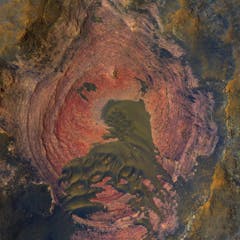
Articles on Mars
Displaying 121 - 140 of 282 articles

From solar sail-powered spacecraft, to laser communications, to asteroid detection systems, there is no shortage of Australian ideas and expertise to help NASA explore the Moon and Mars.

It’s established Mars was once a planet with surface-level water. So with multiple MARS missions starting next year, the key to seeking out martian life may instead lie in the contents of its ‘dust’.

This hot, acidic neighbor with its surface veiled in thick clouds hasn’t benefited from the attention showered on Mars and the Moon. But Venus may offer insights into the fate of the Earth.

An Israeli spacecraft carrying tardigrades crashed into the moon. Whether they will survive is irrelevant.

CC BY-ND30.8 MB (download)
The fifth episode of the To the moon and beyond podcast series explores where we will be travelling in 2069.

Australia played a vital role in beaming the Apollo 11 Moon landing to the world. But since then we’ve passed up the opportunity to cement our place in exploring outer space.

As more than a million people have indicated plans to partake in a citizen ‘raid’ on the famed Area 51 to ‘see them aliens,’ a scholar on the search for extraterrestrial life weighs in on the hype.

The future of lunar exploration and space travel will be possible only through advances in robotic design and implementation.

CC BY-ND44.7 MB (download)
Episode 3 of the To the moon and beyond podcast takes a look at who some of the key players are in the 21st century space race and what they are competing for.

The short answer is yes, but it’s really, really difficult.

Americans need a new multi-decade Moonshot that will inspire several generations to shoot for the stars and pursue careers in space engineering and exploration.

For the first time, an instrument orbiting Mars and a rover on the surface have detected methane simultaneously – raising hopes for finding life on the red planet.

As commercial spaceflight companies lower the cost of reaching space, nations can launch more missions. But while astronauts are great for whipping up enthusiasm, is a manned mission worth the cost?

To prepare for future Mars missions, scientists collect samples and simulate communications conditions from volcano parks on Earth.

Scientists are figuring out how to reduce the cost of space travel – to and from the Moon and possibly to Mars. One approach is to mine the Moon for resources necessary for interplanetary travel.

SpaceX’s advances in space technology have reduced barriers to space and changed the direction of American space policy, but it is not without its challenges.

Rovers including ‘Rosalind Franklin’ will pick up where Opportunity left off – trying to answer the question of whether there is, or ever has been, life on Mars.

Naming features on other worlds is a trickier issue than you might think.

The Earth’s core is cooling down, and one day it will be completely solid – when that happens, Earth might look a lot like Mars.

From turning on instruments to gathering the first data, the next few months will be busy for Mars scientists.
